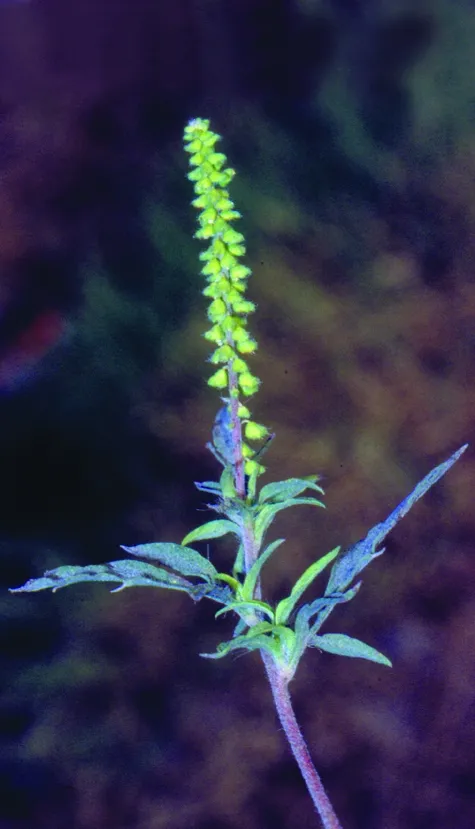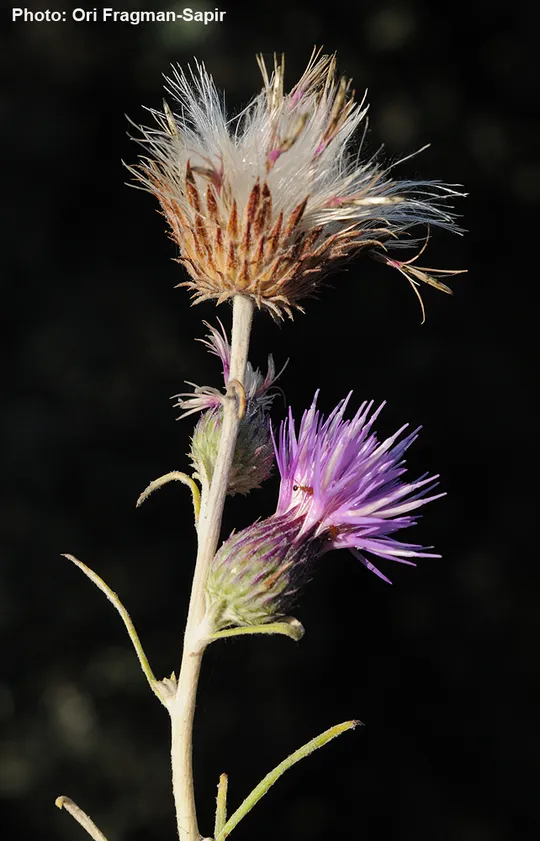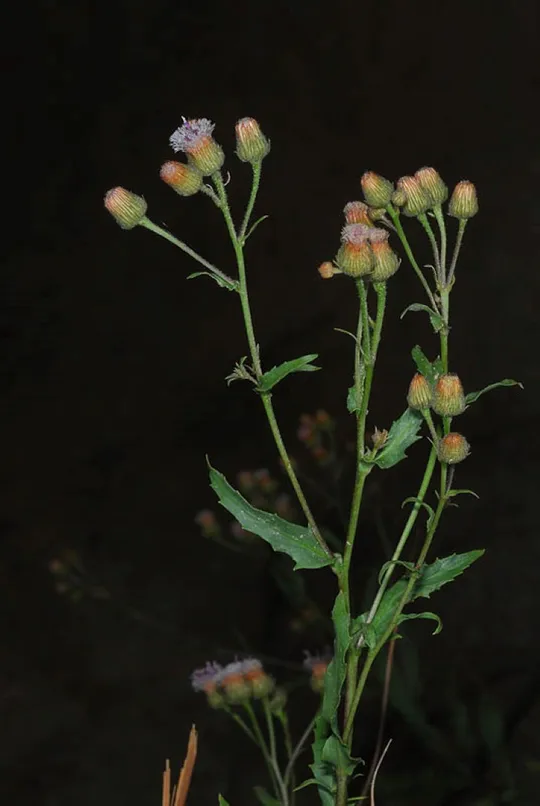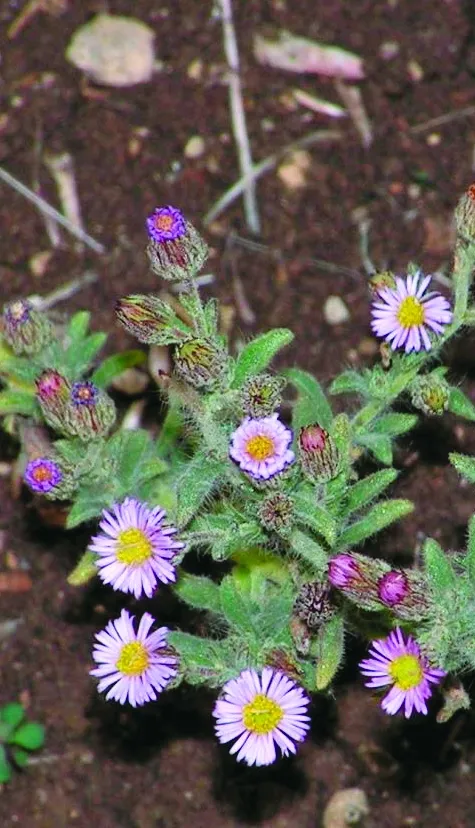Chlamydophora tridentata
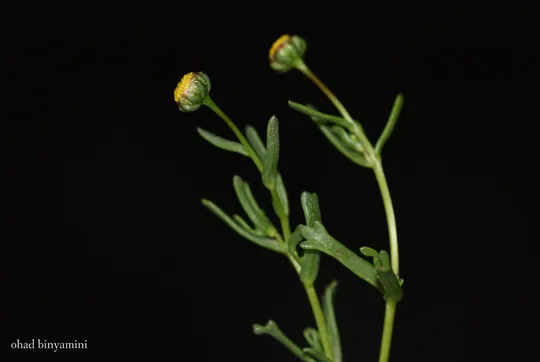
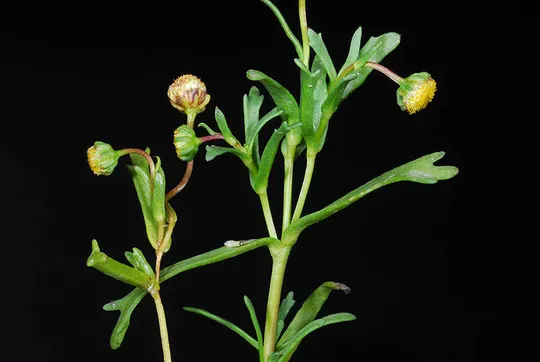
Chlamydophora tridentata is an annual plant with delicate stems, 13-22 cm high. The leaves are elongated, opposite, with entire or toothed margins at the top, sparsely arranged on the stem. The inflorescences are yellow, with no ray florets, similar to the inflorescence of Aaronsohnia; they are arranged on stems, and are 6-8 mm across. The receptacle is convex and all the capitulum (flowering head) flowers are tubular. The achenes are conical with a crown-like ear equal in length to the achene. Flowers in March-April.
A long time ago grew is salt marshes on the Carmel Beach area and on the Dead Sea beach (single observation of Tuvia Kushnir from 1943), early in the 20th century it was also collected along the Jordan River valley. Another observation was made in the Sharon by Danin (2004). Following the rare species survey carried out in the nineties it seem that the Chlamydophora tridentata no longer grows in all of the coastal regions, and has become totally extinct from the Caramel Beach and from the Sea - Dead beach (En Feshha), and that it had survived only in the Jordan Valley. Here it grew in the salt marshes from Wadi Malaha to En Hogla east of Jericho (but since 1931 no further studies were done there). Also grew around the Tirtsa reservoir at the entrance to Wadi Uǧa at the Adam crossing, in En Mahruk and at the Adam junction. In the eighties of the 20th century is also collected in the Bet She'an Valley.
Characteristic of salt marshes that dry up in the summer and of heavy saline soil; also found in depressions in the marl plains (near the Allenby Bridge).
This is a Mediterranean monotypic genus, related to the genus Cotulla.
• The typical habitat of moist, salty heavy soils on the Carmel coast has decreased greatly due to accelerated development. Following agricultural development in the Jordan Valley from the Ǧiftlik area to the Almog-Kalya highway the availability of suitable habitats for Chlamydophora tridentata have significantly decreased; in that region too there is danger of habitat loss outside the area included in the region’s nature reserves.
• The unique habitat requirements of this species have led to severe fragmentation of its populations. The populations that existed on the Carmel coast and at the Dead Sea were very disjuct from the Jordan Valley populations. In the Jordan Valley the habitat is widely distributed and therefore the populations are close to each other.
• Large populations consisting of dozens of individuals were observed in the 1970s in the Jordan Valley. The species’ habitat (saline depressions near springs) has been destroyed since then, and the number of populations and their size has greatly decreased.
• The species is rare in Israel and there is no information about its global distribution and the degree of threat.
• The species is protected in the nature reserves of the Wadi el Ahmar salt marsh and in the Wadi Malaha marshes, where the populations are stable.
The sites where the species grew previously should be located, and efforts should be made to preserve three of them in the Jericho and Uǧa areas. The population of the Wadi Malaha reserve and of the three proposed sites should be monitored annually.
A common species in the Eastern Mediterranean: Israel, Cyprus, Crete, the Aegean Islands, Egypt and Tunis. In the Flora Palestina it is recorded that the species is southern Mediterranean and Saharo-Arabian, but in fact it does not penetrate in the Sahara desert. This difference is of great importance for the preservation of the species, because it turns that in fact its main habitat is on the Mediterranean coast and in the salt marshes nearby. These are places under intensive development, which makes preserving this species particularly important.
An annual plant characteristic of salty moist depressions and the edges of salt marshes; most of its habitats have been destroyed. Found today only in the Jordan Valley from the Oǧa desert plain to the Ǧiftlik. It has become extinct from the Mahruk spring north of the Ǧiftlik and probably from the Jericho plains as well. This pattern of habitat and population vulnerability indicates that the species range is decreasing even in the Jordan Valley, which remains the only region in Israel where Chlamydophora tridentata grew. The rates of habitat loss and of population extinction indicate a need for allocation of special areas in reserves (Wadi Malaha and Wadi el Ahmar) or the allocation of a special reserve.
Current Occupancy Map
| 1000 squre meter pixel | 5000 squre meter pixel | 10000 squre meter pixel | |
|---|---|---|---|
| number of observations | 0 | 0 | 0 |
| in total pixels | 0 | 0 | 0 |
| Family | Asteraceae |
| Classification | On the endangered species list |
| Ecosystem | Mediterranean humid |
| Chorotype | Mediterranean |
| Conservation Site | Wadi Malha Reserve |
| Rarity |
1
3
6
|
|---|---|
| Vulnerability |
0
4
4
|
| Attractiveness |
0
0
4
|
| Endemism |
0
0
4
|
| Red number |
1
3.7
10
|
| Peripherality | 0 |
| IUCN category | DD EW EX LC CR EN VU NT |
| Threat Definition according to the red book | Vulnerable |
 Based on:
Based on:
